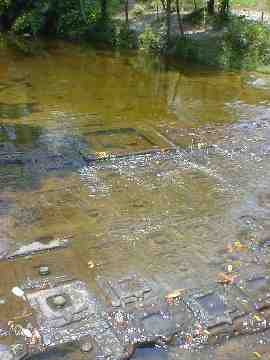|
|
|
| The Buddha at Phnom Kulen |
We left Phnom Penh at 6 a.m. on a Friday morning for our flight to Siem Reap. Even at that hour, the city streets
were rapidly filling up with motorcycles, bicycles, and cars. Crossing the street in Phnom Penh is an adventure.
You have to wait for a small enough break to allow you step off the sidewalk, and then you just head straight for the other
side of the street at a steady pace, letting the traffic flow around you, hoping that the drivers are paying attention.
It was a short flight from Phnom Penh to Siem Reap, in a little Russian plane with bald tires and an air conditioning
system that spilled clouds of condensation on our heads. We headed right out after dropping off our luggage at the hotel,
driving for a couple hours on increasingly rutted roads to Phnom Kulen, the site of an enormous sandstone reclining Buddha.
It's a very popular shrine for the local people, who come to pray at the Buddha's shrine and bathe in the nearby river.
The river is called as the River of a Thousand Lingas, and is notable for having thousands of carvings in its riverbed.
We found a lovely little spot on the river where our guide showed us the lingas (phallic fertility symbols), and a statue.
The site was beautiful enough on its own - a shady glade in the forest where dozens of butterflies swirled in the sun on the
banks of the river, and then I looked down into the clear, shallow water, to see hundreds of lingas cut into the rocky riverbed.
Generally, two questions cross my mind at times like this: "How?" and "Why?"

|
| River of a Thousand Lingas |

|
| Lingas |
The rest of our group was wondering about these questions, too. Unfortunately, our guide was pretty useless when
it came to anything beyond pointing stuff out to us. According to him, everything we saw was done by "Jayavarman the
Second" (or maybe the Seventh? -- accent difficulties) and had to do with Brahmanism. Which, you know, not to say that
that wasn't the case, but it definitely wasn't the whole story. The tourist industry at Angkor apparently hasn't yet developed
to the point of having a critical mass of well-informed tour guides. Or the history of everything is far more obscure than
I would've expected.
We left Phnom Kulen and drove to Kobal Spien, where a long hike into the jungle led us to more carvings in the now-dry
river bed. Judging by the low levels of the river, many of the carvings were probably done during the dry season, when
much of the river bed was exposed. We missed out on the waterfalls, due to the low level of the river, but we got a
very good look at some of the carvings. Its amazing how well they are preserved, considering that they are centuries
old, and covered by running water for part of the year. More damage has been done to the carvings by thieves than by
nature. Our guide pointed out several places where parts of the carving had been hacked away to be sold to art and antiquities
collectors.
The first day was tiring, and the sights we saw weren't spectacular, but they were interesting. Among the local
people at Phnom Kulen were lots of Buddhist monks. They're a striking sight, with their simple, flowing robes, most
often a rich shade of orange, but also golden yellow or deep red. Some behaved like pilgrims, other were more like tourists,
staring around and snapping pictures. Some of the younger ones were even smoking, which looked really incongruous to
me. I wondered at the large numbers of boys and teenagers in monks' robes, until M. explained that many families will
send their boys to be educated by the monks. They dress like monks while they're in school, but not all of the younger
ones will necessarily become monks when their education is finished.

|
| A riverbed carving by Jayavarman the Second, about Brahmanism |
|